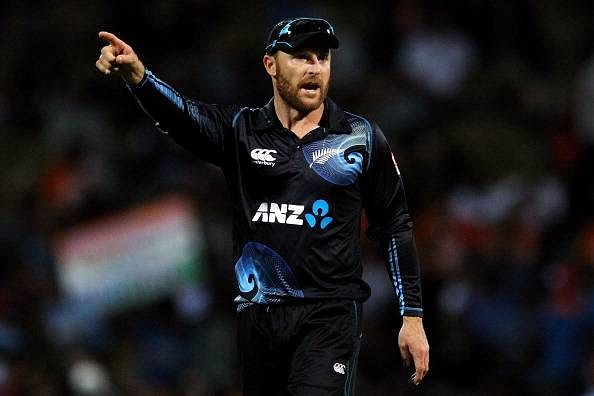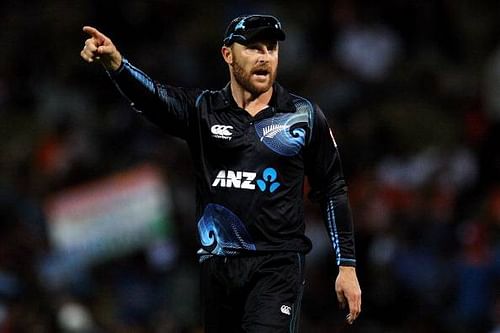
Brendon McCullum: The catalyst behind New Zealand's Metamorphosis

There are moments in cricketing history where the reaching of a climacteric point is almost palpable. Sanath Jayasuriya's (at the time) revolutionary, aggressive batting style, used now as the template for ODI batting, and Sri Lanka's 1996 World Cup victory was a watershed moment in the history of Sri Lankan and world cricket.
It paved the way for a younger generation of players like Sangakkara, Jayawardene, Vaas and Muralitharan to solidify Sri Lanka's position in world cricket as a highly competitive limited-overs side, as evidenced by their two consecutive World Cup Final appearances in 2007 and 2011, and their mauling of India in the 2014 World T20.
Watching Brendon McCullum's New Zealand thrust themselves into the upper echelon of world cricket with aggression that one wouldn’t usually associate with them and one cannot help but be reminded of Sri Lanka's 1996, India's 1983, Australia's 1987 and so many other milestone years of a countrywide resurgence of cricket in the limited-overs game’s short history.
Is this the time? Has New Zealand found their Allan Border or Arjuna Ranatunga? McCullum has truly taken the world by storm: his captaincy has been lauded as daring and tactically brilliant by many former players, critics and commentators, and he has allured fans world over with his fresh style of ODI captaincy and his blitzkrieg batting, in a format that is beginning to disillusion viewers.
The leader is here
Not since Stephen Fleming have New Zealand had such a tactically astute leader; not since Fleming’s era have they had such a varied talent pool, and not since Mark Greatbatch have they had such a destructive opening batsman in Brendon McCullum. New Zealand's most recent Test series draw over England in England, which culminated in a victory at Leeds, despite rain curtailing the game by nearly two days.
The match at Leeds was a magnificent exhibition of tremendously aggressive batting, counterattacking in dire situations, and world-class swing bowling. England were mere spectators to one of the most clinical all-round team performances in recent memory. It definitely showed how much it must have stung New Zealand to have made a first-innings 523 and lost the game on a flat pitch in the first game at Lord’s.
There have been aggressive captains in the past: Sourav Ganguly, Ricky Ponting, Steve Waugh and even Michael Clarke immediately come to mind. But none had the temerity to attempt some of the strange, yet counterintuitively successful strategies attempted by McCullum in his stint so far as captain.
Using up all of his strike bowlers inside 25 overs in the famous ODI against Australia at the World Cup and having four or five men around the bat on a lifeless, non-turning Leeds pitch are a couple of examples of the bizarre and bold tactics that possibly only his side could pull off. McCullum’s sagacious field changes, and his batting aggression can turn the game on its head in less than a session.
The first-ball six in the Leeds game was an illustration of classic McCullum: the innings ended at 41(28) after a lofted slap through the covers, but the impact of the innings was immense; it rattled the fielding side, and allowed the entire lower order to play unshackled cricket. McCullum's aggression has seeped through into the team; and can be seen in the subtle yet highly perceptible changes in their approach to the game, and the character and nerve shown by almost every player in the current line-up.
McCullum's six can be compared to number three Kane Williamson's audacious six in the World Cup game against Australia at Eden Park, where they were nine down and needed six to win. That would perhaps not have happened under Ross Taylor's leadership. This is perhaps the biggest change under McCullum: the will to win is stronger than ever in this New Zealand side.
Ready to dare
He has thrived as a batsman after being handed captaincy: some of his greatest knocks including the triple-century against India and the 202(188) against Pakistan in alien conditions on a dusty Sharjah pitch in the very dark few days following Phil Hughes' untimely death, have come after his elevation to the leadership role. Captaincy has liberated Brendon McCullum the batsman: once an unreliable lower order slogger transformed into the batting mainstay of the New Zealand side.
Giving up the gloves definitely kept the back issues at bay and alleviated a lot of the dual responsibility burden. And in BJ Watling, New Zealand has found a magnificient wicketkeeper with the batting skills to hold his place in the side without even keeping, as he did in the England series. And another veteran keeper, Luke Ronchi, who previously represented Australia, smacked a 70-ball 88 on debut in a high-pressure situation in the second Test.
Tom Latham is a solid opening batsman, and, you guessed it, part-time keeper, who has batted with steadfastness and maturity in his eleven Tests yet, and has made two gritty hundreds, including one in the UAE where all of the others floundered, and where Australia was drubbed just weeks earlier. Martin Guptill’s resurgence in the ODI side has allowed New Zealand to field a settled opening combination, a luxury which they were denied earlier: Peter Fulton, Anton Devcich, Jesse Ryder, Dean Brownlie and Rob Nicol have opened for them in the last few years and none with much success. But Guptill’s reliability, especially in Test matches, is questionable. His lack of off stump awareness and any perceivable foot movement makes him a bad choice for Tests; and that is probably why Hamish Rutherford is being preserved, and has perhaps been groomed, to open in Tests alongside Latham.
Able successor
Above all else, perhaps the chief reason for New Zealand's meteoric rise to the top is McCullum's natural successor as captain, the one-man batting juggernaut, Kane Williamson. Williamson's sound technique, ability to seamlessly transition batting gears, and his unquenchable thirst for runs at just 24, makes him one of the all-weather batsmen that New Zeland have so long craved.
Like Steven Smith, Virat Kohli, and hopefully Azhar Ali, for their respective nations, Kane Williamson is the most vital cog in the batting lineup for New Zealand, upon which most of the team's as well as the opposition's tactics are predicated.
Brendon McCullum's "faith in his bowlers" is another frquently cited reason for New Zealand's recent home and away successes. Trent Boult and Tim Southee are perhaps the best new-ball pairing in the world right now, and New Zealand's greatest by a mile, words echoed by New Zealand's great former fast-bowling all-rounder, Richard Hadlee. The potent right-arm, left-arm combination is a perfect juxtaposition of contrasting bowling styles, in their natural ability to get left and right-handers out more often respectively.
Both have genuine pace and swing the ball viciously and are probably the most integral component of the New Zealand roster. They are ably supported by Matt Henry, Doug Bracewell, Adam Milne, Neil Wagner and Mitchell McClenaghan: the bowling stocks of New Zealand have never been as plentiful, which is perhaps due to tremendous infrastructure and great bowling pitches.
The sport keeps growing
This may be the zenith of New Zealand cricket: Such results were never dreamed of from a side that was whitewashed by Bangladesh and languished at number eight in the ICC rankings as recently as 2013. Looking ahead into the future, New Zealand cricket faces an increasing number of complex challenges. Cricket's struggle to stay relevant across the world is being crushed viciously by the anti-expansionist policies of the ICC and its major stakeholders, the Big Three of India, Australia and England.
The reduced popularity of the Southern Hemisphere's traditionally summer pastime over the years has brought the regular following of the game down, and therefore, the domestic tournament, the Plunket Shield, has produced very few quality players in the last decade or so. Cricket still struggle in New Zealand and has waned in popularity in comparison with their number one sport, Rugby.
But co-hosting the 2015 World Cup and reaching the final in Melbourne, with an inspiring performance, New Zealand have done enough to address the financial and popularity dilemmas that continue to plague them today.
The strength of the New Zealand side, and the depth in its talent pool may experience immense fluctuations in the future: just as those of Sri Lanka and Pakistan have before them, although Sri Lanka and Pakistan are third-world nations with little permanent cricketing infrastructure, corruption and poor pitches. Smaller nations such as these tend to experience severe dips in their talent reserves due to their low population and a lack of regular followers of the game.
New Zealand's great infrastructure and bowler-friendly pitches can ensure a slight security, at least. Brendon McCullum and his men face the tough challenge, now, of keeping the team together as a closely-knit unit, which can continue to produce giant-beating results, and can perhaps convince the ICC to relieve the world of its wringing control on cricket, and hopefully expand the game to smaller nations, so that the struggle of the game of cricket to stay relevant may have purpose.